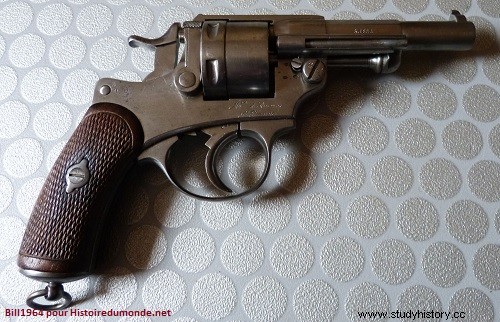
We know the personal investment of Napoleon III to ensure that the French army was equipped with a truly modern rifle; it will be the rifle model 1866, said Chassepot. Unfortunately the effort stopped there and the handgun did not follow, as it is true that it had never had any real tactical value and represented only a personal defense weapon.
When the conflict of 1870 broke out, the very old (and very old-fashioned) pommel pistol of the model 1822Tbis was still in service. A single-shot, percussion, muzzle-loading weapon, its ballistic properties were almost those of the flintlock pistols of ancient times; the Lefaucheux revolver had indeed been adopted by the Navy a few years earlier (1858), but the Army still only has the old pommel pistol.

Most officers and more generally those who could afford it, equipped themselves at their own expense with civilian gunsmiths; especially Lefaucheux revolvers, copies of the models adopted by the navy, firing metal pinfire cartridges, but also all the models then available on the market.
These heterogeneous weapons made the war of 1870, in the hands of many horsemen and almost all officers; they proved to be of some use and the scrapping of old pommel pistols was therefore acquired.
The conflict ended, in the catastrophic way that we know, the The Artillery wanted to make people forget the inertia and retrograde spirit which they were rightly reproached with during the Second Empire. He therefore proceeded to examine all the revolvers available on the civilian market which used metallic cartridges; whether pinfire, rimfire or centerfire.
The Lefaucheux revolver had been the most popular and widely used during the conflict, but it was out of date by 1871 and the navy had just adopt a robust and powerful revolver, equipped with a cartridge with central percussion. De facto, the other modes of percussion were abandoned to retain only the principle of central percussion.
Logic would have it that the Navy and the Army were equipped with the same weapon, but the latter decided to acquire a weapon of its own.
A revolver proposed by the gunsmiths Chamelot and Delvigne was retained, with some modifications requested by the Artillery Committee. The weapon was robust, relatively simple, functioned with double action and drew a cartridge with central percussion well designed, it was put in test as of 1872 in the corps of troop and adopted the following year under the name of “revolver model 1873” .
While it is rare for the first regulation weapon of a new type to be immediately a success, the 1873 is an exception to the rule:a small gunsmith's masterpiece, it is undoubtedly the most successful French handgun, and one of the best post-1870 weapons.
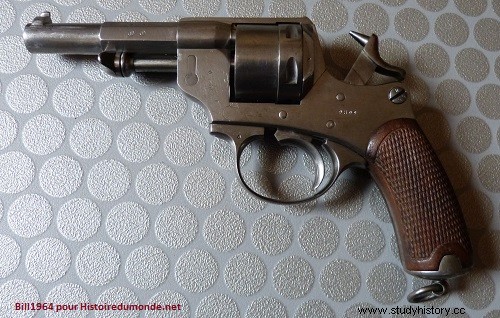
A ministerial decision of August 17, 1874 determined “the adoption of the model 1873 revolver for arming all non-commissioned officers, brigadiers and soldiers of cavalry regiments, mounted artillery and the train of military crews who are not provided with rifles or carabiners, as well as for arming in the field of adjutants and sergeants-major of infantry”.
On October 31, 1874, the model 1873 revolver, slightly modified, was approved for the armament of all officers. This model, slightly shorter, lighter due to the milling of grooves on the cylinder, endowed with a beautiful “dark blue” tan, took the name of “revolver model 1874”.
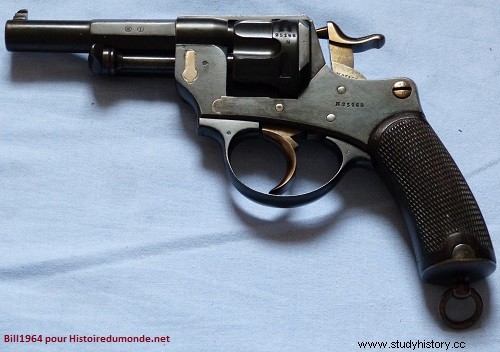
The Navy itself adopted the Model 1873 revolver for sailors and the model 1874 for officers, replacing the model 1870 revolver, of which it however retained for a time the 12 mm cartridge for which the new revolvers were adapted.
Replaced officially in 1892 by a new revolver more modern and more powerful, the 1873 nevertheless continued, necessity being law, to be used during the First World War and, although more rarely, during the second, in particular in the Resistance.
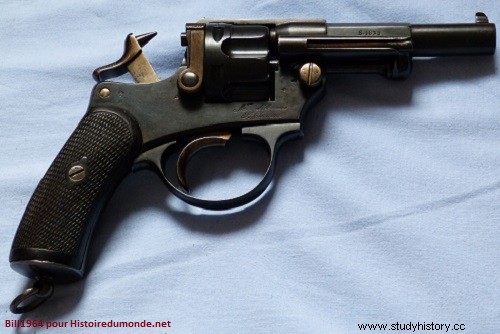
If we must find a defect in the 1873 and 1874 revolvers, it is indeed on the side of the ammunition that it is necessary to look, and not on the side of the weapon in itself; particularly anemic, the original cartridge offered only a third of the power of the cartridge of the 1870 marine revolver.
A new ammunition manufactured from 1890 was to be more powerful, but the instruction manual for the model 1873 revolver nevertheless specified that:“even at point-blank range, the bullet of the revolver produces no effect on the breastplate of the regulatory breastplate; on the back, it forms slight depressions”…
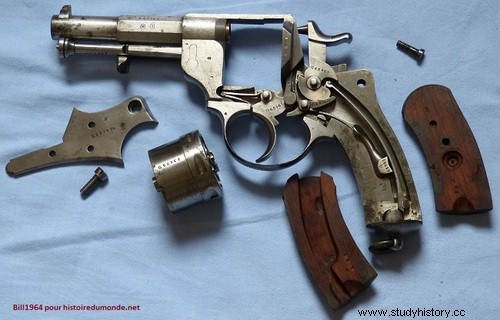
DESCRIPTIVE SHEET:
Overall length :242 mm for the 1873 for troops, 228 mm for the 1874 for officers.
Barrel length :114 mm for the 1873, 110 mm for the 1874.
Weight :1.18 kg for the 1873, 1.00 kg for the 1874.
Calibre :11 mm.
Barrel capacity :6 shots.
Canon striped with 4 stripes on the right, at 35 cm intervals.
Aim in white at 25 meters.
Finish of the weapon :polished white for the 1873, bronzed “dark blue” for the 1874.
